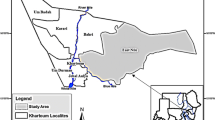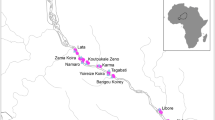Abstract
The efficiency of S. mansoni miracidia in locating and infecting Biomphalaria pfeifferi in Gezira canals has been studied under field conditions. When S. mansoni eggs were introduced into clean stagnant water in small field channels, the miracidia hatched to infect 100% of 30 snails in cages at the release point. Fifteen metres upstream and downstream 13% of caged snails were infected but no infections were found in snails 20 m away.
When eggs were released into the same canal in flowing water (8.3 cm · s−1), no infections were detected in any of the caged snails placed 0–100 m downstream. Releasing hatched miracidia instead of eggs resulted in infections in all cages at 5 m intervals from 0-100 m. The release of eggs into flowing water was likened to the method by which S. haematobium eggs are deposited during urination. The 0% infection suggests that eggs will be swept away from the point of contamination by the flow. Thus only urination into stagnant water will lead to heavy snail infection rates.
When eggs were released into a small pond-like minor canal tail end snail infection rates were only 3%. This was probably due to the larger water volume, smaller number of caged snails, and the presence of vegetation and other fauna which may be decoys or predators.
The results highlight how very high snail infection rates can be produced under ideal conditions but also show how large snail and miracidia numbers are required in natural situations.
Similar content being viewed by others
References
Chernin, E. & Dunavon, C. A., 1962. The influence of host-parasite dispersion upon the capacity of Schistosoma mansoni miracidia to infect Australorbis glabratus. Am. J. trop. Med. Hyg. 11: 455–471.
Fenwick, A., Cheesmond, A. K. & Amin, M. A., 1981. The role of field irrigation canals in the transmission of Schistosoma mansoni in the Gezira Scheme, Sudan. Bull. Wld. Hlth. Org. 59: 777–786.
Shiff, C. J., 1968. Location of Bulinus (Physopsis) globosus by miracidia of Schistosoma haematobium. J. Parasit. 54: 1133–1140.
Upatham, E. S., 1973. Location of Biomphalaria glabrata (Say) by miracidia of Schistosoma mansoni Sambon in natural standing and running waters on the West Indian Island of St. Lucia. Int. J. Parasit. 3: 289–297.
Webbe, G., 1966. The effect of uratus velocities on the infection of Biomphalaria sudanica tanganyicensis exposed to different numbers of S. mansoni miracidia. Am. J. trop. Med. Parasit. 60: 85–89.
Author information
Authors and Affiliations
Rights and permissions
About this article
Cite this article
Babiker, A., Fenwick, A. & Amin, M.A. Location of Biomphalaria pfeifferi by Schistosoma mansoni miracidia in stagnant and running water under field conditions. Hydrobiologia 110, 235–240 (1984). https://doi.org/10.1007/BF00025795
Issue Date:
DOI: https://doi.org/10.1007/BF00025795




